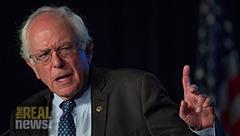Bernie Sanders Is Doing Something More Than Just Running for President
As the senator barnstorms New York state, he’s staging a modern-day, secular revival.
Rochester—The crowd that showed up to hear Bernie Sanders on Monday morning was the biggest the local hockey rink’s manager, Kim Davis, had ever seen. Some arrived the night before, camping out in the snow on lawn chairs to secure a place in line. By 6 am—four hours before Sanders was scheduled to appear—all the rink parking lots were full. When Hillary Clinton came through last Friday the local cable channel reported that “hundreds packed into the gym” for her speech. Three days later Sanders drew over 6,000.

Jeff Lofton was one of them. A young African American who’d just come off his shift at Walmart—“I had to stop at home to drop off my box cutter”—he works a second job at a nursing home to make ends meet. “I wanted to go see Trump, too. But I had to work,” he said. “I want to see things for myself before I make up my mind.”
By the time Sanders reached the point in his stump speech where he talks about how “people are exhausted. Tired of working 50 to 60 hours a week,” and reminds the crowd that 100 years ago the labor movement in the US began with the demand for a 40-hour work week—“And we’re still fighting for a 40-hour week!”—Loftus was nodding along. And when Sanders, who has sharpened, and personalized, his attacks on what he calls “the billionaire class,” called out the Walton family, who own Walmart, for paying their workforce so badly many are forced to rely on food stamps and Medicaid, demanding they “Get off of welfare and pay your workers a living wage,” he was pumping his fist in the air with the rest of the crowd.
Although Sanders criticized Clinton for accepting money from Wall Street—and pointed out that Goldman Sachs, the bank that paid Hillary Clinton $675,000 for three speeches, had just the day before agreed to pay a $5 billion settlement for defrauding investors—never mentioned the hundreds of thousands of dollars that Alice Walton has donated to Hillary Clinton’s Super PAC. Instead, as he did in Buffalo the night before, Sanders gave the crowd a brief tutorial on the issues involved in the Verizon strike—which saw 36,000 workers walk off their jobs this morning—connecting their fight with the history of the labor movement. And as he does in every stump speech now, he followed that with an invocation of the civil-rights movement, “when brave people stood up together and decided to fight back against hundreds of years of racism.” Then he moved on to “the feminist movement, when millions of women stood up together,” adding, as he always does, “and I know every man in this room is going to stand with the women in their fight for pay equity.” Then, when the cheers died down, he reminded the crowd of the victories achieved by “the gay rights movement, who stood up, with their straight allies, to demand the right for people to love one another regardless of gender.”
On paper this may sound like mere genuflection, or virtue-signaling. But in the room it felt more like a revival—of a peculiarly, determinedly secular kind perhaps, but with the same mobilizing effect on its audience as any tent meeting. It made visible their own power—in this case the power to change, not themselves but society. By invoking radical history, Sanders is summoning up radical hope. “The American dream is that parents work hard so their kids can do better,” he tells his audiences, pledging “we will not allow the American dream to die.”
Warming up the crowd in Syracuse later that afternoon Rosario Dawson reminded them that Sanders had been in this fight for a long time. “Oftentimes we have watched him [Sanders] talking to an empty room.” She gestured to the thousands packed into the Onecenter and said, “We have filled up that space.”
Dawson, who has long combined activism with her acting career, brought a different kind of charisma to the campaign. Reminding the audience that under New York’s incumbent-protecting election laws registered independents needed to switch by last October to vote in next week’s Democratic primary, Dawson commanded: “If you’re an independent, don’t stay home on Tuesday. Make sure you find at least two people to vote for you. Don’t wait until November!”
Because, as Dawson didn’t say, by November they may not have the chance. Though Sanders has won eight of their last nine contests, Clinton retains a commanding lead in pledged delegates. If she wins her home state—where she has not only the governor in her corner but also his sometime sparring partner Mayor Bill de Blasio—Sanders can, and should, still carry the fight to the convention, but without much hope of becoming the nominee. The conventional wisdom says New York’s convoluted election laws, fierce ethnic rivalries, and still-functioning urban Democratic party machines mean Sanders doesn’t have a chance here. The most recent poll put Clinton 12 points up statewide, with an even bigger lead in New York City.
Of course Clinton was also ahead in Michigan—until the votes were counted. But New York politics is a tougher league. To win here, Sanders will have to do more than defy the Democratic Party organization—he’ll have to overwhelm it. Drawing crowds—even yuuuge crowds—isn’t enough if he can’t get those crowds out to vote on Tuesday.
Could that happen? Nobody really knows—including me. Anecdotally, I can offer the African-American woman who checked me in for my flight in Buffalo, and told me, “I tried to go to the rally, but I couldn’t get in” when she saw my Bernie button. Or the Amtrak worker at Penn Station—also an African-American woman—who took my previous Bernie button. Or Katrinna Martin-Bordeaux, chair of Young Black Democrats of Western New York, who told me Clinton’s support among her community is a lot softer than people think. Will the firewall that lifted Clinton in the South leave her whistling Dixie in New York? We’ll find out on Tuesday.
But as I drove yesterday from Buffalo to Rochester to Syracuse, I remembered that this part of New York State had once been the center of a revival that eventually swept the whole country. Religious in origin, this early-19th-century Great Awakening also sparked the abolitionist movement, the feminist movement—Seneca Falls, where the abolitionists Elizabeth Cady Stanton and Lucretia Mott issued the first declaration of women’s rights in 1848, is just a short turn off the Thruway between Rochester and Syracuse—and socialist communities in Skaneateles and Oneida.
From Erie County westward to the middle of the state, the fervor of this revival—and the movements it called into being—was so strong that Charles Finney, a leader of the Awakening who later became its chronicler, coined a special name for the region. He called it “the burned-over district.” •
*D.D. Guttenplan is The Nation's Editor-at-Large.
Disclaimer: The views expressed here are the author's personal views, and do not necessarily represent the views of Newsclick
Get the latest reports & analysis with people's perspective on Protests, movements & deep analytical videos, discussions of the current affairs in your Telegram app. Subscribe to NewsClick's Telegram channel & get Real-Time updates on stories, as they get published on our website.
























